“Who are the people that have nurtured your heart? Your husband your children, your mother?
“What has inspired you to write an article on the [autumn] equinox? What has nurtured your body? Good food? It is about reflecting on that and actually allowing you an opportunity to focus on what you’re grateful for.
“Gratitude is a very important part of being balanced and in harmony with the environment,” says druid Eimear Burke in her opening introduction.
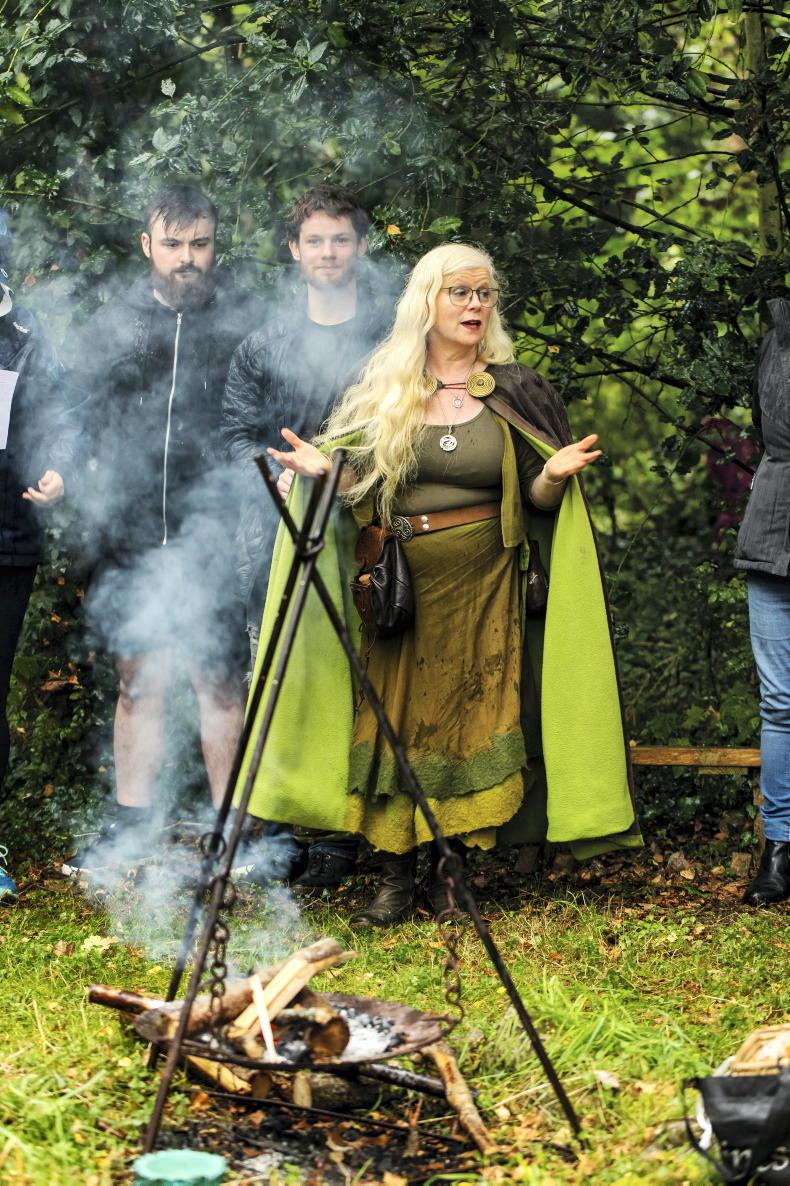
Eimear Burke. \ Philip Doyle
The rain poured down my face as I stood in Eimear’s grove in Co Kilkenny at her celebration of the autumn equinox.
The group – unperturbed by the persistent autumn shower – stood in a circle and listened as each in turn gave thanks and elucidated their hopes for the future. There is a lot of pain and hurt among this small group and what is evident is that they have found solace or a “safe place” in this small circle.
Before the ceremony commenced I asked Eimear, who in 2020 became the chief druid of the Order of Bards, Ovates and Druids (OBOD) what exactly is druidry?
“If you asked 11 druids that question, you’d get 12 answers” she replies but gives me her version nonetheless.
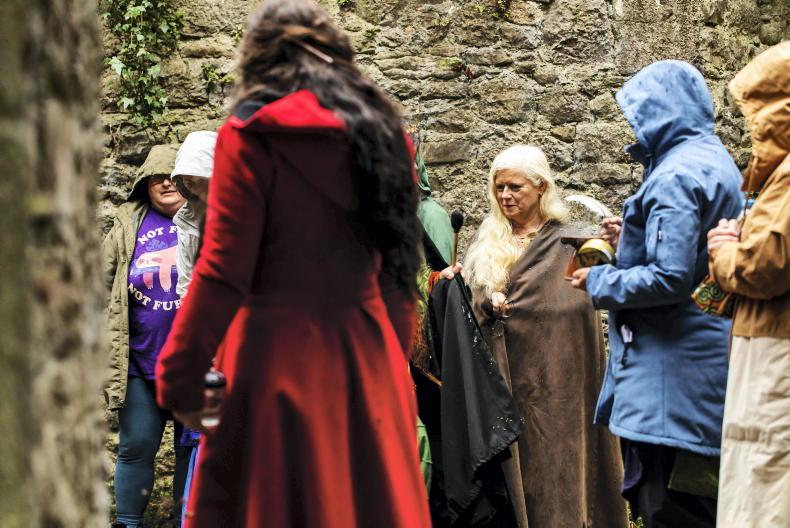
“Druidry is a nature-based spiritual path. It’s about that central connection with the land and the landscape, and the seasons. We have an inner landscape and then there’s the outer landscape so we like to have balance and harmony with our outer landscape so we follow the seasons of the year and mark them with ceremonies.
“There are eight fold ceremonies and this is the autumn equinox, the second harvest.”
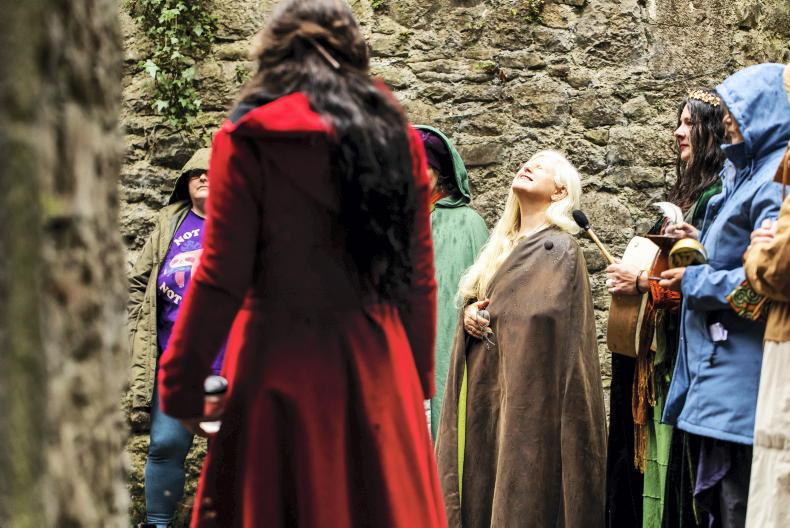
The story teller
Within druidry there are three strands – bard, ovate and druid. Eimear is a bard, a storyteller, but explains that when she started her training she didn’t regard herself as a storyteller.
As a psychologist she wanted to be an ovate and also she looked at her husband Harold (RIP) writing his poetry, which she felt she couldn’t do.
“I couldn’t play an instrument, although I learned in school very badly. And I certainly wasn’t a poet, or anything like that. But through that process, not that anybody taught me how to tell stories, that was I suppose called out in me. I absolutely love telling stories and I took up the harp then.
“I’m interested in the stories and how they relate to the landscape. And I’m also interested in Irish place names because they give you a sense of spiritual place as well. We’d done a lot of that [learning about our mythology] in primary school. I mean the nuns were great actually telling us about all the old myths and legends.”
Halloween
Considering the issue we are writing this article for, I ask about Samhain (Halloween) which is the next festival on their calendar. Eimear explains that “there’s that notion now that Samhain marks the beginning of the Celtic New Year.
“Think of all the people that have invaded us [we accept that there were a lot]. We, Irish people, are not Celtic, there are no genetic markers. But the Celts when they came, they did leave their culture. They left their music, their culture, stories, and languages” – and their festivals, including Samhain. Samhain is said to be the time when the veil that separates the worlds of the living and the dead is at its thinnest. Therefore it is little surprise that this night has become so wrapped up in the superstitions we are so familiar with.
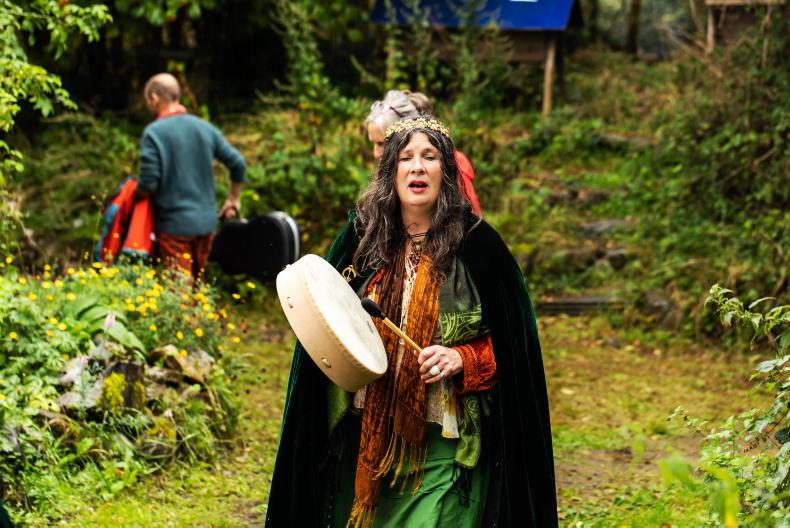
Deirdre Wadding. \ Philip Doyle
According to OBOD: “On this night the Cailleach (the Crone) comes to strip the leaves from the trees, to quicken the decay of the flesh of the year, so that it may feed the new life to come.
“We can also ask her to take the unwanted aspects of our personal year away, so that these too might be transformed.”
Journey to druidry
Eimear wanted to be a doctor and admits that she didn’t work hard enough in school to achieve that aim, becoming first a nurse and then a psychotherapist instead.
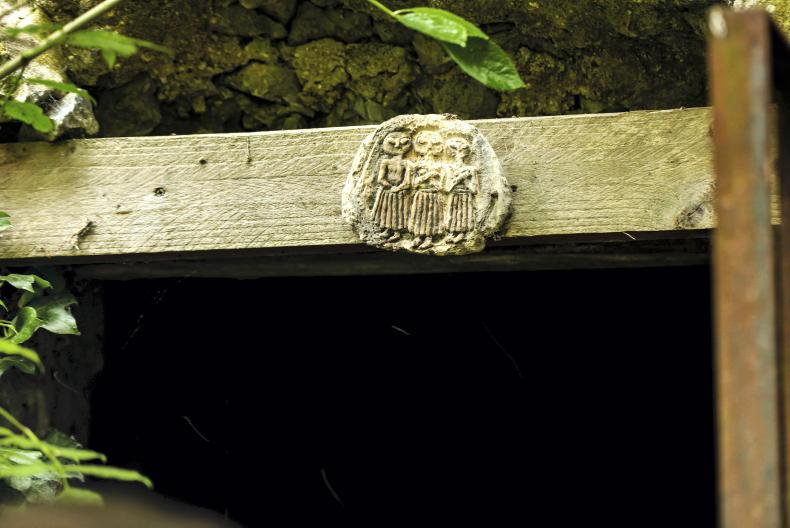
“My interest in nature-based spirituality came from when I worked in Africa, in the ’80s and again in the ’90s. I was fascinated by African traditions and I’d also worked with a Native American medicine woman.
“I happened to be in a bookshop one day and a book jumped out which was Cassandra Eason’s The Modern-Day Druidess, and I liked it – the practicality, that you didn’t have to be deep in the forest to be a druid. That you could create your own grove in your own environment.”
This is exactly what Eimear did in three castles in north Kilkenny.
Eimear signed up to an introductory course before going on to complete her training over a seven-year period.
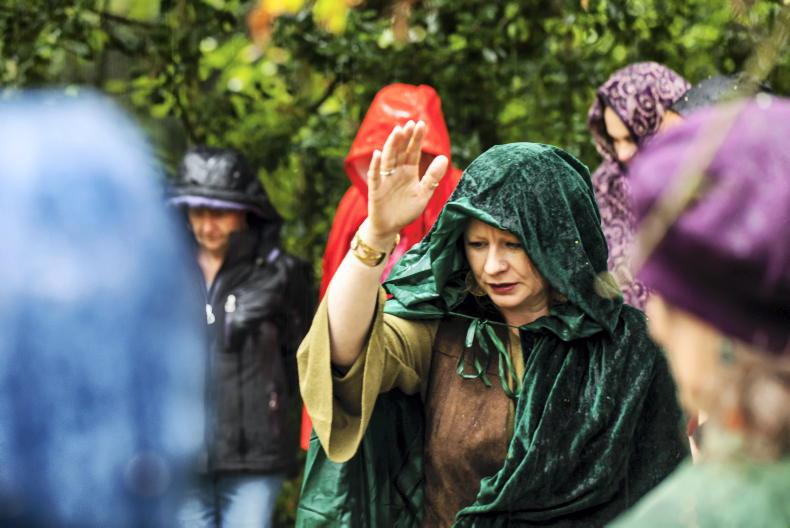
Cáit Branigan. \ Philip Doyle
That first summer, she held her first autumn equinox ritual and 18 years later this is where Irish Country Living found itself on a very wet day.
But it is welcoming to all. Eimear tells us that “there are many people who come, who have a strong resonance with the ceremonies, who wouldn’t recognise themselves as druids, but they’re still drawn to this and are very much part of our community”.
Female empowerment was a topic arising across many conversations, with many telling stories of how women healers have been oppressed throughout Irish history. In Irish cailleach, “veiled one”, means a wise or spiritual woman. 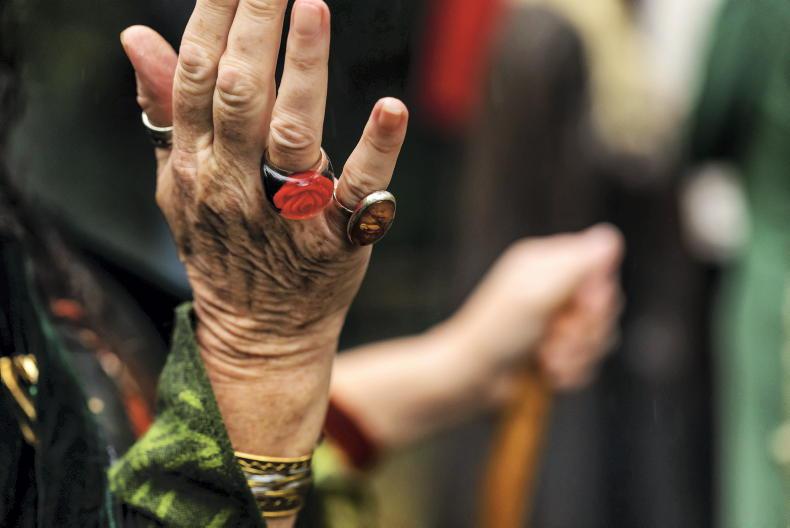
The cailleach or crone is synonymous in folklore with wisdom and female autonomy operating outside of patriarchy, which resulted in women with healing abilities being branded as witches.
Also called a “hag” (and many Irish places carry that name) the cailleach feasa is the “wise woman, fortune-teller” and cailleach phiseogach is the “sorceress, charm-worker”.
Cáit Brannigan
Cáit Brannigan is also a druid in OBOD but her day job is in her own personal healing practice in Wexford.
“My family, we have traditional healers in our lineage on my mother’s side. So it’s [the practice] a mixture of the traditional, Shamanic arts as well as old fashioned healing hands-on and herbs. I think in Ireland, it’s always been there. Every town has always had their healer.”
Cáit takes a holistic view as to what is happening with the body: “We look at what else is going on in the person’s life, that’s contributing. People are balancing modern mainstream medicine with traditional practices.”
Witch
There are actually very few witchcraft cases in Ireland. Alice Kytler is probably the most famous and Bridget Cleary the most recent, which Cáit points out was really a murder.
She attributes this [lack of persecution] to the Irish having a level of respect for traditional healers and for practitioners of spirituality.
“At a certain point in the 1800s, the Church started to preach against them, but they never really stamped it out. But if you look at the continent, it’s a very different situation that there was a very active persecution of people who worked traditionally. In France, they still haven’t repealed the witchcraft act.
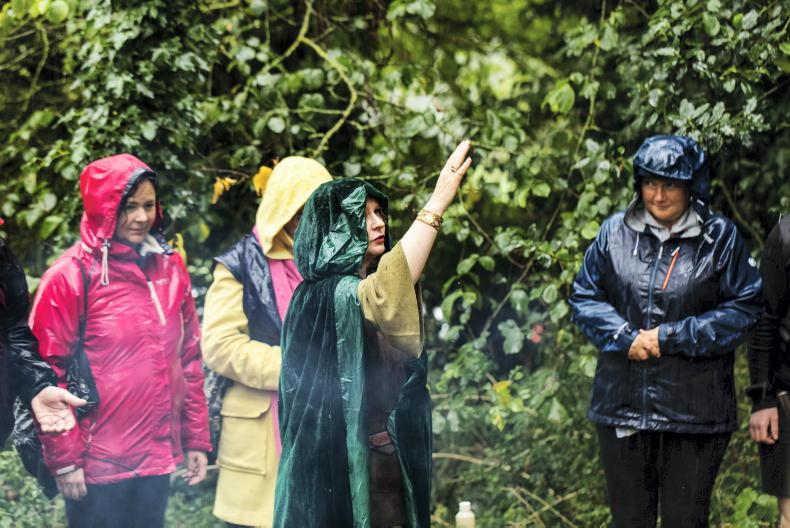
“My great granny, her cure book – which is a herbal book – had a lot of prayers out of the Christian faith. We’ve always had the capacity to weave the different traditions together. Traditional healers aren’t respected necessarily by the medical professional overtly. But it’s not something I’m worried about. I can work on the main street of my town and there is no peculiarity about it.”

Irish Country Living asked Eimear to tell us a story for Halloween. This is the Story of Jack-O-Lantern.
Jack was a handsome man, big and strong with many friends. In the midst of a battle, a beautiful woman dark of hair and eye with pale skin drew close and spoke to Jack.
“Come with me Jack” she said, “for I love Thee, and would have Thee with me for all time.”
But Jack was frightened, for he recognised the woman as the Morrígan and he replied: “I know thee – thou art the Morrígan, the chooser of the slain and I am not ready to die.” She turned in anger and disappeared but as he stood an enemy cut his face and he was no longer handsome.
Time passed and Jack learned to play the harp. While travelling, he stopped at an Inn and was served dinner by a beautiful woman with dark eyes and raven tresses around her pale face.
When Jack went to leave the women said “Do not travel further, Come with me Jack, for I love Thee, and I would have Thee with me for all time.”
But Jack was frightened and still not ready to die and again repeated “I know thee – thou art the Morrígan, the Phantom Queen, and I am not ready to die.”
The Goddess in pride and anger disappeared into the shadow.
Jack continued on but his horses spooked, his wagon overturned and he was gravely wounded but did not die, losing an arm so he could not play his harp any more.
Time passed and everyone grows old and after his last brother’s death, Jack was crossing a small river when he noticed something strange. Across the river an old woman was crouched by the water, covered by dark, shapeless rags. She was washing something in the river and her arms were red with blood up to her elbows as was the water she touched. To his horror, Jack noticed that what she was washing was his own best shirt that he was wearing for his brother’s funeral. The old woman looked up, and said “Cross the river, and come to me, Jack, “for I love Thee, and I would have Thee with me for all time.”
Again Jack saw the Morrígan “I know thee – thou art the Morrígan, the Hag, the Washer at the Ford, and I am not ready to die.”
Suddenly, the Great Queen stood in all Her Otherworldly majesty, the dark rags magically transforming into the dark wings of a raven.
“Thou art a fool, Jack!” Thrice thy time came, thrice I offered thee my love and thrice you rejected me out of fear. Now I reject thee. Never more shall I come to thee. Never more shall I call to thee. But by my curse thou shalt live for as long as this candle burns.”
Then she was gone.
At first, Jack was terrified the candle would burn down within minutes. But not a drop of wax rolled down its side.
Time passed. Year after year, and everyone whom Jack had known passed away, while he lived on and on, getting older and older, and weaker and weaker. All he knew was that he had to keep his candle burning, lest he die.
His house fell into ruin, his field went untended, and all that would grow there were some turnips. In a storm Jack took one of the turnips, carved it into a lantern, and put his candle inside to protect it from the rain.
He then started wondering alone with his lantern, looking and calling to friends and family long gone. His body grew older and older, until the flesh disappeared, leaving only a spirit without physical substance. Forever cursed by his fear.
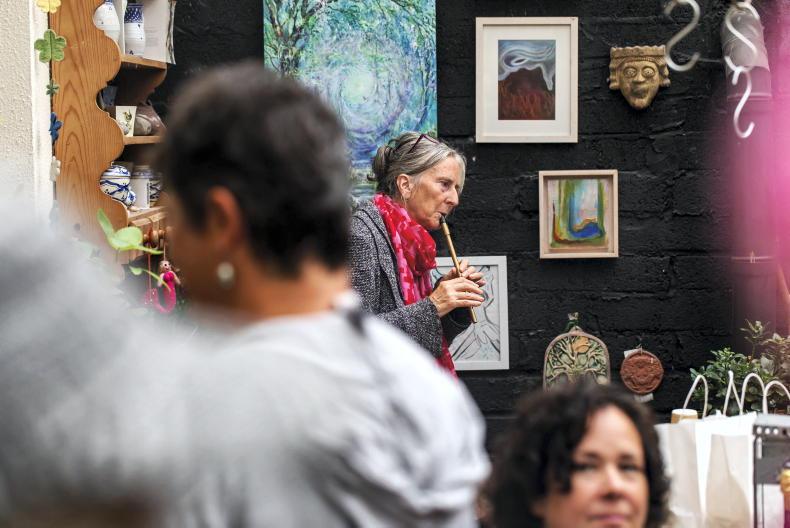
After the ceremony, there is a pot luck feast, with each attendee bringing food to share with the gathering. Then, there is a Night Court which is a space for Bardic offering, whether of music, poetry, story or song. \ Philip Doyle
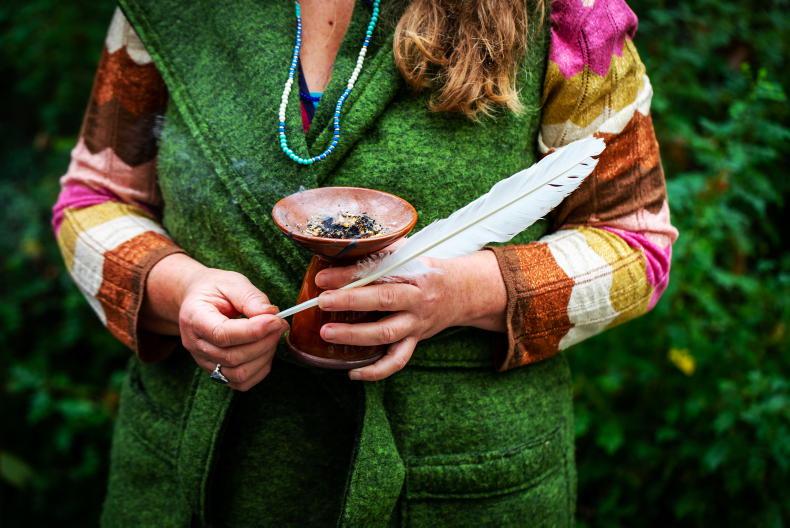
The cleansing. \ Philip Doyle
“So I made a blend of herbs I grow myself and then frankincense, which is always that cleansing, cleansing clearing protecting herbs just to bless you. Maybe I might pick moss from the paths of Danu or [leaves] picked on a sacred site or something from here.”
The Morrígan, the shape shifter who favoured the crow, the Phantom queen was one of the Tuatha De Danann, who were the “folk of the Goddess Danu”.
Read more
Entertainment: the Halloween events guide
These Halloween cookies are a great mid-term activity
“Who are the people that have nurtured your heart? Your husband your children, your mother?
“What has inspired you to write an article on the [autumn] equinox? What has nurtured your body? Good food? It is about reflecting on that and actually allowing you an opportunity to focus on what you’re grateful for.
“Gratitude is a very important part of being balanced and in harmony with the environment,” says druid Eimear Burke in her opening introduction.

Eimear Burke. \ Philip Doyle
The rain poured down my face as I stood in Eimear’s grove in Co Kilkenny at her celebration of the autumn equinox.
The group – unperturbed by the persistent autumn shower – stood in a circle and listened as each in turn gave thanks and elucidated their hopes for the future. There is a lot of pain and hurt among this small group and what is evident is that they have found solace or a “safe place” in this small circle.
Before the ceremony commenced I asked Eimear, who in 2020 became the chief druid of the Order of Bards, Ovates and Druids (OBOD) what exactly is druidry?
“If you asked 11 druids that question, you’d get 12 answers” she replies but gives me her version nonetheless.

“Druidry is a nature-based spiritual path. It’s about that central connection with the land and the landscape, and the seasons. We have an inner landscape and then there’s the outer landscape so we like to have balance and harmony with our outer landscape so we follow the seasons of the year and mark them with ceremonies.
“There are eight fold ceremonies and this is the autumn equinox, the second harvest.”

The story teller
Within druidry there are three strands – bard, ovate and druid. Eimear is a bard, a storyteller, but explains that when she started her training she didn’t regard herself as a storyteller.
As a psychologist she wanted to be an ovate and also she looked at her husband Harold (RIP) writing his poetry, which she felt she couldn’t do.
“I couldn’t play an instrument, although I learned in school very badly. And I certainly wasn’t a poet, or anything like that. But through that process, not that anybody taught me how to tell stories, that was I suppose called out in me. I absolutely love telling stories and I took up the harp then.
“I’m interested in the stories and how they relate to the landscape. And I’m also interested in Irish place names because they give you a sense of spiritual place as well. We’d done a lot of that [learning about our mythology] in primary school. I mean the nuns were great actually telling us about all the old myths and legends.”
Halloween
Considering the issue we are writing this article for, I ask about Samhain (Halloween) which is the next festival on their calendar. Eimear explains that “there’s that notion now that Samhain marks the beginning of the Celtic New Year.
“Think of all the people that have invaded us [we accept that there were a lot]. We, Irish people, are not Celtic, there are no genetic markers. But the Celts when they came, they did leave their culture. They left their music, their culture, stories, and languages” – and their festivals, including Samhain. Samhain is said to be the time when the veil that separates the worlds of the living and the dead is at its thinnest. Therefore it is little surprise that this night has become so wrapped up in the superstitions we are so familiar with.

Deirdre Wadding. \ Philip Doyle
According to OBOD: “On this night the Cailleach (the Crone) comes to strip the leaves from the trees, to quicken the decay of the flesh of the year, so that it may feed the new life to come.
“We can also ask her to take the unwanted aspects of our personal year away, so that these too might be transformed.”
Journey to druidry
Eimear wanted to be a doctor and admits that she didn’t work hard enough in school to achieve that aim, becoming first a nurse and then a psychotherapist instead.

“My interest in nature-based spirituality came from when I worked in Africa, in the ’80s and again in the ’90s. I was fascinated by African traditions and I’d also worked with a Native American medicine woman.
“I happened to be in a bookshop one day and a book jumped out which was Cassandra Eason’s The Modern-Day Druidess, and I liked it – the practicality, that you didn’t have to be deep in the forest to be a druid. That you could create your own grove in your own environment.”
This is exactly what Eimear did in three castles in north Kilkenny.
Eimear signed up to an introductory course before going on to complete her training over a seven-year period.

Cáit Branigan. \ Philip Doyle
That first summer, she held her first autumn equinox ritual and 18 years later this is where Irish Country Living found itself on a very wet day.
But it is welcoming to all. Eimear tells us that “there are many people who come, who have a strong resonance with the ceremonies, who wouldn’t recognise themselves as druids, but they’re still drawn to this and are very much part of our community”.
Female empowerment was a topic arising across many conversations, with many telling stories of how women healers have been oppressed throughout Irish history. In Irish cailleach, “veiled one”, means a wise or spiritual woman. 
The cailleach or crone is synonymous in folklore with wisdom and female autonomy operating outside of patriarchy, which resulted in women with healing abilities being branded as witches.
Also called a “hag” (and many Irish places carry that name) the cailleach feasa is the “wise woman, fortune-teller” and cailleach phiseogach is the “sorceress, charm-worker”.
Cáit Brannigan
Cáit Brannigan is also a druid in OBOD but her day job is in her own personal healing practice in Wexford.
“My family, we have traditional healers in our lineage on my mother’s side. So it’s [the practice] a mixture of the traditional, Shamanic arts as well as old fashioned healing hands-on and herbs. I think in Ireland, it’s always been there. Every town has always had their healer.”
Cáit takes a holistic view as to what is happening with the body: “We look at what else is going on in the person’s life, that’s contributing. People are balancing modern mainstream medicine with traditional practices.”
Witch
There are actually very few witchcraft cases in Ireland. Alice Kytler is probably the most famous and Bridget Cleary the most recent, which Cáit points out was really a murder.
She attributes this [lack of persecution] to the Irish having a level of respect for traditional healers and for practitioners of spirituality.
“At a certain point in the 1800s, the Church started to preach against them, but they never really stamped it out. But if you look at the continent, it’s a very different situation that there was a very active persecution of people who worked traditionally. In France, they still haven’t repealed the witchcraft act.

“My great granny, her cure book – which is a herbal book – had a lot of prayers out of the Christian faith. We’ve always had the capacity to weave the different traditions together. Traditional healers aren’t respected necessarily by the medical professional overtly. But it’s not something I’m worried about. I can work on the main street of my town and there is no peculiarity about it.”

Irish Country Living asked Eimear to tell us a story for Halloween. This is the Story of Jack-O-Lantern.
Jack was a handsome man, big and strong with many friends. In the midst of a battle, a beautiful woman dark of hair and eye with pale skin drew close and spoke to Jack.
“Come with me Jack” she said, “for I love Thee, and would have Thee with me for all time.”
But Jack was frightened, for he recognised the woman as the Morrígan and he replied: “I know thee – thou art the Morrígan, the chooser of the slain and I am not ready to die.” She turned in anger and disappeared but as he stood an enemy cut his face and he was no longer handsome.
Time passed and Jack learned to play the harp. While travelling, he stopped at an Inn and was served dinner by a beautiful woman with dark eyes and raven tresses around her pale face.
When Jack went to leave the women said “Do not travel further, Come with me Jack, for I love Thee, and I would have Thee with me for all time.”
But Jack was frightened and still not ready to die and again repeated “I know thee – thou art the Morrígan, the Phantom Queen, and I am not ready to die.”
The Goddess in pride and anger disappeared into the shadow.
Jack continued on but his horses spooked, his wagon overturned and he was gravely wounded but did not die, losing an arm so he could not play his harp any more.
Time passed and everyone grows old and after his last brother’s death, Jack was crossing a small river when he noticed something strange. Across the river an old woman was crouched by the water, covered by dark, shapeless rags. She was washing something in the river and her arms were red with blood up to her elbows as was the water she touched. To his horror, Jack noticed that what she was washing was his own best shirt that he was wearing for his brother’s funeral. The old woman looked up, and said “Cross the river, and come to me, Jack, “for I love Thee, and I would have Thee with me for all time.”
Again Jack saw the Morrígan “I know thee – thou art the Morrígan, the Hag, the Washer at the Ford, and I am not ready to die.”
Suddenly, the Great Queen stood in all Her Otherworldly majesty, the dark rags magically transforming into the dark wings of a raven.
“Thou art a fool, Jack!” Thrice thy time came, thrice I offered thee my love and thrice you rejected me out of fear. Now I reject thee. Never more shall I come to thee. Never more shall I call to thee. But by my curse thou shalt live for as long as this candle burns.”
Then she was gone.
At first, Jack was terrified the candle would burn down within minutes. But not a drop of wax rolled down its side.
Time passed. Year after year, and everyone whom Jack had known passed away, while he lived on and on, getting older and older, and weaker and weaker. All he knew was that he had to keep his candle burning, lest he die.
His house fell into ruin, his field went untended, and all that would grow there were some turnips. In a storm Jack took one of the turnips, carved it into a lantern, and put his candle inside to protect it from the rain.
He then started wondering alone with his lantern, looking and calling to friends and family long gone. His body grew older and older, until the flesh disappeared, leaving only a spirit without physical substance. Forever cursed by his fear.

After the ceremony, there is a pot luck feast, with each attendee bringing food to share with the gathering. Then, there is a Night Court which is a space for Bardic offering, whether of music, poetry, story or song. \ Philip Doyle

The cleansing. \ Philip Doyle
“So I made a blend of herbs I grow myself and then frankincense, which is always that cleansing, cleansing clearing protecting herbs just to bless you. Maybe I might pick moss from the paths of Danu or [leaves] picked on a sacred site or something from here.”
The Morrígan, the shape shifter who favoured the crow, the Phantom queen was one of the Tuatha De Danann, who were the “folk of the Goddess Danu”.
Read more
Entertainment: the Halloween events guide
These Halloween cookies are a great mid-term activity


















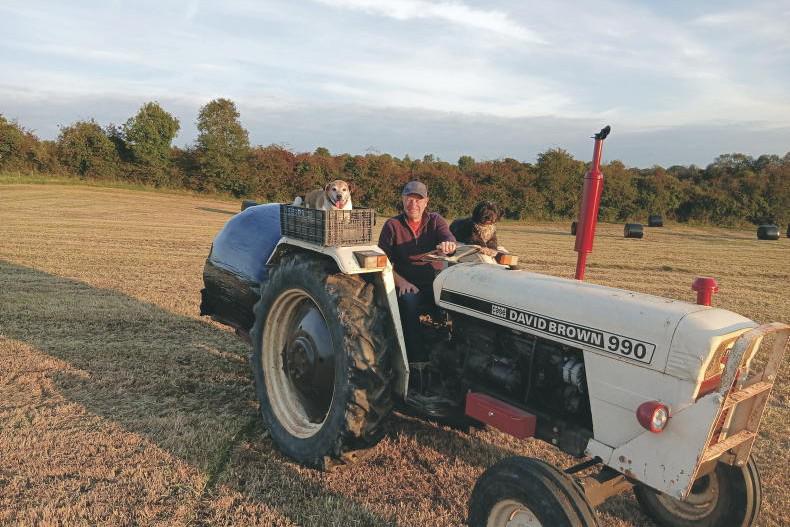

SHARING OPTIONS